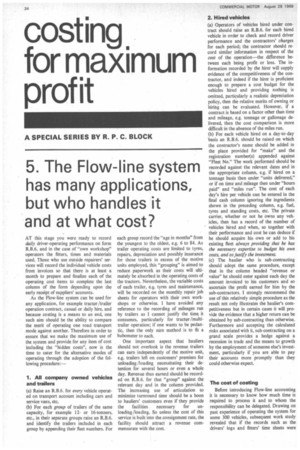costing for maximum profit
Page 36

If you've noticed an error in this article please click here to report it so we can fix it.
5. The Flow-line system has many applications, but who handles it and at what cost?
AT this stage you were ready to record daily driver-operating performance on form R.B.6, and in the case of "own workshop" operators the fitters, times and materials used. Those who use outside repairers' services will record the individual vehicle costs from invoices so that there is at least a month to prepare and finalize each of the operating cost items to complete the last column of the form depending upon the early receipt of suppliers' accounts.
As the Flow-line system can be used for any application, for example tractor /trailer operation contract, casual or daily hire, and because costing is a means to an end, one such aim should be the ability to compare the merit of operating one road transport mode against another. Therefore in order to ensure that we make the maximum use of the system and provide for any item of cost including the "hidden costs", now is the time to cater for the alternative modes of operating through the adoption of the following procedure: 1. All company owned vehicles and trailers (a) Raise an R.B.6. for every vehicle operated on transport account including cars and service vans, etc.
(b) For each group of trailers of the same capacity, for example 12or 16-tonners, etc., in their separate groups raise an R.B.6. and identify the trailers included in each group by appending their fleet numbers. For
each group record the "age in months" from the youngest to the oldest, e.g. 6 to 84. As trailer operating costs are limited to tyres, repairs, depreciation and possibly insurance for those trailers in excess of the motive units employed, this "grouping" is aimed to reduce paperwork as their costs will ultimately be absorbed in the operating costs of the tractors. Nevertheless, the variable costs of each trailer, e.g. tyres and maintenance, will be recorded on the monthly repair job sheets for operators with their own workshops or otherwise. I have avoided any reference to the recording of mileages run by trailers as I cannot justify the time it consumes, particularly for tractor/multitrailer operation; if one wants to be pedantic, then the only sure method is to fit a hubometer to each.
One important aspect that hauliers should not overlook is the revenue trailers can earn independently of the motive unit, e.g. trailers left on customers' premises for unloading /loading necessitating their detention for several hours or even a whole day. Revenue thus earned should be recorded on R.B.6. for that "group" against the relevant day and in the column provided_ The increasing use of articulation to minimize turnround time should be a boon to hauliers' customers even if they provide the facilities necessary for unloading/loading. So unless the cost of this service is built into the consignment rate, the facility should attract a revenue commensurate with the cost. (a) Operators of vehicles hired under contract should raise an R.B.6. for each hired vehicle in order to check and record driver performance and the contractors' charges for each period; the contractor should record similar information in respect of the cost of the operation—the difference between each being profit or loss. The information recorded by the hirer will supply evidence of the competitiveness of the contractor, and indeed if the hirer is proficient enough to prepare a cost budget for the vehicles hired and providing nothing is omitted, particularly a realistic depreciation policy, then the relative merits of owning or hiring can be evaluated. However, if a contract is based on a factor other than time and mileage, e.g. tonnage or gallonage delivered, then the cost comparison is more difficult in the absence of the miles run.
(b) For each vehicle hired on a day-to-day basis an R.B.6. should be raised on which the contractor's name should be added in the place provided for "make" and the registration number(s) appended against "Fleet No." The work performed should be recorded against the relevant dates and in the appropriate column, e.g. if hired on a tonnage basis then under "units delivered," or if on time and mileage then under "hours paid" and "miles run". The cost of each day's hire per vehicle can be entered in the final cash column ignoring the ingredients shown in the preceding column, e.g. fuel, tyres and standing costs, etc. The private carrier, whether or not he owns any vehicles, then has a record of the number of vehicles hired and when, so together with their performance and cost he can deduce if he should acquire his own or add to his existing fleet always providing that he has the necessary expertise to budget his own costs, and so justry the investment.
(c) The haulier who is sub-contracting should adopt the same procedure, except that in the column headed "revenue or value" he should enter against each day the amount invoiced to his customers and so ascertain the profit earned for him by the sub-contractors. I strongly recommend the use of this relatively simple procedure as the result not only illustrates the haulier's competitiveness but in certain cases it will provide the evidence that a higher return can be obtained by sub-contracting than otherwise. Furthermore and accepting the calculated risks associated with it, sub-contracting on a grand scale provides a hedge against a recession in trade and the means to growth by the employment of someone else's investment, particularly if you are able to pay their accounts more promptly than they could otherwise expect.




































































































